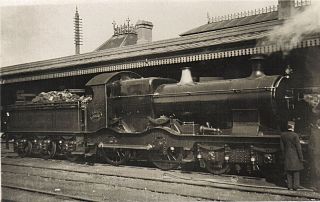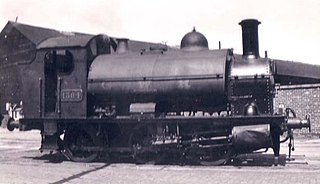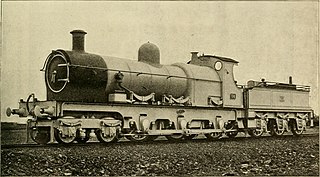
The GWR 4100 Class was a class of steam locomotives in the Great Western Railway (GWR) of the United Kingdom.

The Bulldog and Bird classes were double-framed inside cylinder 4-4-0 steam locomotives used for passenger services on the Great Western Railway. The Bird Class were a development of the Bulldogs with strengthened outside frames, of which a total of fifteen were built. A total of 121 Bulldogs were built new, with a further twenty rebuilt from Duke Class locomotives. Thirty Bulldogs were later rebuilt as Earl Class locomotives and renumbered 3265, 3200-3228.

The Great Western Railway Caesar Class were 0-6-0 broad gauge steam locomotives. They were designed by Daniel Gooch for goods train work. This class was introduced into service between June 1851 and February 1852, and withdrawn between June 1871 and June 1880.

The Great Western Railway Premier Class 0-6-0 broad gauge steam locomotives for goods train work. This class was introduced into service between February 1846 and May 1847, and withdrawn between March 1866 and June 1872.
The Great Western Railway (GWR) Bogie Class4-4-0ST were broad gauge steam locomotives for passenger train work. The first two locomotives of this class were introduced into service in August/September 1849, with the remainder following between June 1854 and March 1855. All but one were withdrawn between October 1871 and 1873, with the final locomotive being withdrawn in December 1880.

The Great Western Railway Prince Class 2-2-2 broad gauge steam locomotives for passenger train work. This class was introduced into service between August 1846 and March 1847, and withdrawn between January and September 1870.

The 1361 Class were small 0-6-0ST steam locomotives built by the Great Western Railway at their Swindon Works, England, mainly for shunting in docks and other sidings where track curvature was too tight for large locomotives.

The Great Western Railway (GWR) 4500 Class or Small Prairie is a class of 2-6-2T steam locomotives.

The Dean Single, 3031 Class, or Achilles Class was a type of steam locomotive built by the British Great Western Railway between 1891 and 1899. They were designed by William Dean for passenger work. The first 30 members of the class were built as 2-2-2s of the 3001 Class.
The 3521 Class were forty tank locomotives designed by William Dean to haul passenger trains on the Great Western Railway. They were introduced as 0-4-2T locomotives in 1887, but were quickly altered to become 0-4-4Ts to improve their running. Following two serious accidents they were further altered from 1899 to run as 4-4-0 tender locomotives, in which form the last was withdrawn in 1934.

The Hercules Class were four broad gauge steam locomotives for the Great Western Railway. They were the first 0-6-0 locomotives, being built in 1842 by Nasmyth, Gaskell and Company.
The first 19 locomotives ordered by Isambard Kingdom Brunel for the Great Western Railway included six 2-2-2 Charles Tayleur locomotives. They were built by Charles Tayleur and Company, which became later the Vulcan Foundry. The locomotives were unsuccessful and rapidly supplemented by the Star Class locomotives ordered by Daniel Gooch once he had been appointed as the Locomotive Engineer. As built, they comprised two groups of three: the first group, delivered in 1837, had cylinders having a bore of 14 inches (360 mm) and the second group, delivered in 1838, had cylinders having a bore of 12 inches (300 mm); all had a stroke of 16 inches (410 mm).
Hurricane was the second of a pair of steam locomotives built for the Great Western Railway (GWR) by R. & W. Hawthorn & Co. whose design was very different from other locomotives. In order to meet Isambard Kingdom Brunel's strict specifications, a 2-2-2 frame carried the 'engine', while the boiler was on a separate six-wheeled frame.
George Armstrong was an English railway engineer. He was in charge of standard gauge steam locomotives for the Great Western Railway at Stafford Road Works, Wolverhampton, from 1864 to 1897. He was the younger brother of his colleague Joseph Armstrong, but thanks to the special requirements of the GWR at a time when it was split in two by the broad and standard gauges, the brothers were able to work largely independently of each other. George is best remembered for his 0-4-2 and 0-6-0 tank engines; these were long-lived, and even when life-expired they were replaced by Collett and Hawksworth with remarkably similar locomotives, the well-known 1400, 5700 and 1600 classes.

A haycock boiler is an early form of steam locomotive boiler with a prominently raised firebox of "Gothic arch", "haystack", or "coppernob" shape. The term haystack is most commonly used, but is avoided here as it is confusingly used for three quite different forms of boiler. This particularly large outer firebox served as the steam dome and was often highly decorated with polished brass. These were popular for early railway locomotives, from 1840 to the 1850s.

The Queen Class was Joseph Armstrong's last class of 2–2–2 express engine for the Great Western Railway, larger than the Sir Daniel Class of about a decade earlier. They worked express trains for almost 30 years, and were in effect the predecessors of the larger Singles of William Dean.

The 2602 Class was a series of steam locomotives designed by William Dean and built at the Swindon Works of the Great Western Railway.

GWR No. 36 was a prototype 4-6-0 steam locomotive constructed at Swindon Works for the Great Western Railway in 1896, the first 4-6-0 ever built for the GWR and one of the first in Britain. It was designed by William Dean and le Fleming comments that "the design is unusual and entirely Dean of the later period, including the only large boiler ever built entirely to his ideas."

The GWR 101 Class consisted of a single experimental 0-4-0T side-tank steam locomotive. It was built at GWR Swindon Works under the direction of George Jackson Churchward in June 1902.
The LCDR Brigand class was a pair of steam locomotives of the 0-4-2 wheel arrangement supplied to the London, Chatham and Dover Railway (LCDR). They were designed by Patrick Stirling for the Glasgow and South Western Railway (GSWR), which ordered twenty in 1860 from Sharp, Stewart & Co.. At this time, the LCDR needed more locomotives but had little money available, so their locomotive superintendent, William Martley, visited various manufacturers to find out what was available quickly and cheaply. He arranged for two of the locomotives ordered by the GSWR to be delivered instead to the LCDR – they arrived in August 1861, two more being ordered from Sharp, Stewart for the GSWR as replacements.














